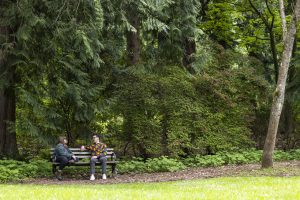Shade Crusade: Why City Trees Are Good Medicine
Sandra Hines · UW Magazine · March 2008
Featuring Kathleen Wolf and Nancy Rottle, Nature and Health researchers

A shopping blog for “green, eco-friendly pet owners” features a dog collar made from recycled inner tubes and lined with silver seatbelt material.
A so-called “eco-luxury” vodka uses only locally grown grain and comes in a bottle of recycled glass for what the Missouri distiller says is, a “vodka with a green state of mind.”
And now you can go green to the grave with biodegradable coffins. It’s composting at its best, says the owner of Natural Burial in Portland, Ore., which sells products like the Ecopod, a kayak-shaped coffin made out of recycled newspapers.
Seems like everything and everybody is going green these days.
But where is the green going? American Forests, a Washington, D.C., nonprofit, found that America’s largest cities have lost more than a quarter of their tree canopies since 1972. In Seattle, the city’s urban forester Mark Mead, ’82, ’87, says that 18 percent of the city has canopy cover, down from 40 percent just 35 years ago. That’s about half of what is recommended for a city of its size, according to American Forests.
“If we don’t have urban green in our surroundings, our lives are diminished. And it’s usually taken for granted until it’s gone.”
Kathleen Wolf, UW College of Forest Resources